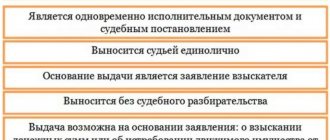Is it possible to withdraw the application?
Alimony is paid only according to executive documents - a voluntary agreement, a court order or a writ of execution. After contacting the bailiff service with the appropriate application, enforcement proceedings are launched. The procedure for disposing of executive registers is regulated by the Federal Law “On Enforcement Proceedings” dated October 2, 2007 No. 229-FZ.
The law regulates both how to use executive documents and how to withdraw an application for alimony. The application for alimony must be collected within 5 days after it is submitted, since after this period the Federal Bailiff Service (FSSP) will begin to formalize enforcement proceedings. Despite the fact that there is no significant difference between the withdrawal of a writ of execution and an application for alimony, taking away the register of enforcement proceedings is more difficult than applying for financial support for a minor.
There can be many reasons for a recall. They are not regulated by law and are not official in nature. Typically, the withdrawal of an application for alimony is initiated by the recipient himself. The court may decide otherwise (if the revocation occurs in court), because refusal of alimony may entail a deterioration in the financial situation of a minor child and a violation of his financial interests. Moreover, the Family Code of the Russian Federation strictly stipulates the responsibility of parents to provide for their minor children.
A parent may voluntarily refuse to receive child support, since this is not prohibited by law. If a party is able to independently ensure the normal functioning of their child without forcing the finances of the second parent, then withdrawing the application will not be difficult.
The motives can be completely different - from psychological, when the parties are on bad terms and do not want to interact with each other, to completely rational ones. An example would be the sudden dismissal or serious illness of the alimony payer. If the financial or social situation worsens, paying alimony becomes very difficult, therefore, the recipient may decide to withdraw the application for such payments.
How else can you explain the withdrawal of the application? The reason may be an official change in the collection procedure - the obligation to pay the minor’s financial support is transferred from one party to the other. Parental rights to a child can also be transferred. The court may even deprive the alimony payer of parental rights by specifying in its decision how to distribute the obligation to pay alimony. You can also withdraw your application due to the employment of a minor with subsequent receipt of income.
Parents may have various reasons for withdrawing an application. However, if the interests of the child are infringed, and representatives of the guardianship authorities prove this, then the court may oblige the parent to pay child support without fail (Parts 2, 3 of Article 80 of the RF IC).
As in the case of drawing up writs of execution, you can withdraw an application for alimony in three ways:
- at a notary's office by drawing up an appropriate agreement;
- in the bailiff service before the initiation of enforcement proceedings;
- in a court.
The choice of authority is made depending on how far the alimony case has gone. If the parties have no particular objections, then the issue is resolved peacefully by drawing up an agreement. If funds for the maintenance of a minor are already being collected, then court intervention cannot be avoided.
What practice shows
In cases of alimony cancellation, the court first of all takes into account the interests of the child.
In this regard, decisions on the abolition of deductions for child support are adopted only if there are compelling arguments.
Let's look at an example.
Citizen Ivanov A.V. paid monthly child support from a dissolved marriage with Ivanova I.R. in the amount of 25% of earnings. Ivanova I.R. three years after the breakup, she married O.P. Gromov, who is an individual entrepreneur.
Ivanov A.V. filed a claim for the cancellation of alimony on the basis that Ivanova I.R. remarried, and Gromov I.P. actually provides child support.
The court refused the plaintiff, since remarriage is not a reason to stop paying child support, stepfather Gromov I.P. is not the adoptive parent of the child and is not obliged to provide for him financially, and this obligation is not removed from the father.
Does the father have the right to child support? The answer is presented in the article “Can the father of a child apply for alimony for his maintenance.” You can find out how alimony is paid to your ex-wife here.
How to withdraw a voluntary application?
Filing an application for child support is an official recognition of the obligation of one of the parents to pay financial support to a minor dependent. If the parties have no disagreements, then they draw up a voluntary agreement in which they reflect all their terms.
In the contract, you can refuse monthly payments and offer another option for financial assistance - real estate or property assets. Parents can also discuss the option of making a one-time payment of the entire amount due. In this case, an application for alimony is not drawn up, which means that the parties do not have problems with how to collect it.
In order for the alimony agreement to receive legal force, it must be certified by a notary. The initial agreement must necessarily indicate the payer's contribution to providing for the minor child, otherwise the notary will simply refuse to certify it.
If during the execution of the agreement one party decides to voluntarily refuse alimony, then the agreement must be amended accordingly and then signed by a notary.
How to withdraw an application from bailiffs?
The applicant can withdraw the application for alimony from the bailiff service within up to 5 days. After this period, the writ of execution will have to be revoked. This does not change the right of the alimony recipient to refuse alimony.
To complete the enforcement proceedings, a special application is submitted to the territorial branch of the SSP. In the text of the appeal you must indicate:
- Recipient's name and address;
- Full name and address of the payer;
- name and number of the bailiff service department;
- name and details of the writ of execution;
- terms of payments under a court decision;
- requirement to withdraw an application for alimony;
- grounds that clearly explain the position of the parties.
The SSP considers the application for no more than 4 days and makes its decision. If all the rules stipulating how to withdraw an application for alimony are met, the bailiff will prepare a decree to complete the collection.
The child must be provided for by his parents until he comes of age, therefore the alimony recipient has the right to apply for the recovery of maintenance again.
A citizen can exercise this right at any time before the end of the parties’ obligations to provide financial support for minor children (up to 18 years of age for a dependent). If one of the parties decides to withdraw the application for alimony, this will in no way prevent it from being resubmitted in the future.
Is it possible to notarize payments - instructions
If a notarial agreement on the payment of alimony has been concluded between the parties to an alimony obligation, they have the right to apply to a notary for its termination. In this case, the document must be drawn up in writing and subject to notarization. The algorithm of actions in this case is as follows:
- The parties reach agreement on the terms of termination of the contract.
- Drawing up an agreement. You can draw up the document yourself, or ask a notary to draw it up.
- Preparation of necessary documents.
- Payment of the state fee for notarization of the termination agreement in the amount of 200 rubles. - Part 1, Clause 12, Art. 333.24 Tax Code of the Russian Federation.
- Certification of the agreement by a notary.
If a party does not agree to terminate the document, the other has the right to go to court.
What should the agreement contain?
It states:
- Place of detention (populated area).
- Date of conclusion: day, month and year.
- The title of the document is “On termination of the agreement to pay alimony.”
- Full names of the parties, passport details and place of registration/residence.
- Information about the child - full name, date of birth and who is provided to him by the parties.
- Date, number of the originally concluded agreement.
- Information about the notary.
- Signatures of the parties.
What documents will be required
To have an agreement certified by a notary you will need:
- Passports of the parties.
- Draft agreement or draft version thereof.
- Children's birth certificates/passports for children aged 14 to 18 years.
- Marriage/divorce certificates.
- Receipt for payment of state duty.
Important! An additional fee may apply for the service of preparing an agreement by a notary.
Agreement on termination of alimony payment agreement (DOC 30 KB)
How to withdraw an appeal through court?
Now let’s find out how to withdraw an application for alimony when initiating legal proceedings. The appeal must be submitted to the same judicial body that made the initial decision, or to the arbitration court at the location of the bailiff (Part 1 of Article 45 of the Federal Law No. 229-FZ).
This process involves several stages:
- The applicant formalizes the response by drawing up an application for waiver of claims. The parent must provide the court with reasons for their decision to refuse.
- The judge considers the presented arguments regarding compliance with the rights and material interests of the child, involving the guardianship service.
- The process is completed if the verification does not reveal any violations in relation to the minor dependent. After the judge makes a decision, the plaintiff can withdraw the application for alimony.
In the appeal, the applicant must indicate the reasons for the revocation and attach to the letter a copy of his passport, the child’s birth certificate and a writ of execution (court order or sheet). As an attachment, you can add an agreement of the parties to waive alimony payments or a receipt for a one-time payment of financial support.
After satisfying the request to terminate the alimony case, the plaintiff sends a notice to the bailiff. Review of this document is carried out within three days. The decision taken comes into force immediately (Part 4 of Article 45 229-FZ).
If the plaintiff decides to refuse alimony before the start of enforcement proceedings, he may not use the received executive document, that is, not send it to the employer or bailiff. In this case, you only need to notify the FSSP of the decision not to initiate enforcement proceedings against the alimony payer.
Where to contact
It is necessary to file a claim for cancellation of alimony to the judicial institution located at the defendant’s place of residence.
If the applicant is the payer of the payments, then the defendant in the case will be the recipient. And, conversely, when filing a claim at the initiative of the recipient, the defendant is the supporter of the child or relative.
If the court decision on the payment of alimony has entered into force and is being carried out in the order of writ proceedings, then in order to stop the payments you need to petition the court for an order to cancel the payments. If payments are accrued through a claim, the applicant must submit an application for their cancellation in the same manner.
What are the consequences of refusal?
The revocation of executive documents can only be a temporary measure, while the obligation of parents to provide for their children lasts until their dependents come of age. The court document on alimony does not lose its validity even after the recipient has decided to withdraw his application. Payments can be resumed at any time.
Moreover, if the alimony payer has arrears on current payments, it does not disappear and is not written off when the alimony agreement is revoked. The citizen retains the obligation to repay the debt, only it is now collected not forcibly, but voluntarily. The amount of debt is fixed at the time of withdrawal of the executive documentation.
If, after a lapse of time, the recipient decides to resume alimony payments, he can again enter into a voluntary agreement or a court order. There is no need to update the writ of execution. In such cases, the recipient again turns to the bailiff service with an application to resume payments and presents the previously issued sheet. The bailiff initiates enforcement proceedings and issues a corresponding resolution.
Collection can be carried out even for the period during which the refusal of alimony payments was issued. This can only be done if the bailiffs receive complete evidence of non-payment of funds within the specified time. The period cannot exceed three years.
The bailiffs themselves will calculate the required amount and begin forced collection. If payments have been received, and the alimony payer can provide all the evidence (checks, receipts, bank statements), then funds to support the child will begin to be collected from the moment the enforcement proceedings are resumed.
Sources:
“Family Code of the Russian Federation” dated December 29, 1995 No. 223-FZ
Federal Law “On Enforcement Proceedings” dated October 2, 2007 No. 229-FZ
Regulatory framework
| Laws | Articles |
| Family code | Article 48 describes how the origin of a minor child can be established. Article 52 explains how maternity or paternity can be challenged. Article 70 explains the peculiarities of legal proceedings in cases related to the annulment of parental rights. Article 71 contains a list of restrictions for parents deprived of rights in relation to their child. Article 120 describes the grounds upon the occurrence of which the payment of alimony is terminated. Article 125 describes the peculiarities of the judicial process when considering adoption cases. Article 129 describes the ways in which parents have the right to give consent to the adoption of children by other people. Article 130 contains a list of circumstances when parental consent for adoption is not required. Article 137 contains a list of the legal consequences of adoption. |
| Tax Code (Part 2) | Article 333.19 contains the amount of fees paid by the interested party for the proceedings in court. Article 333.26 contains the amount of fees paid by the applicant before receiving government services at the Civil Registry Office. |









